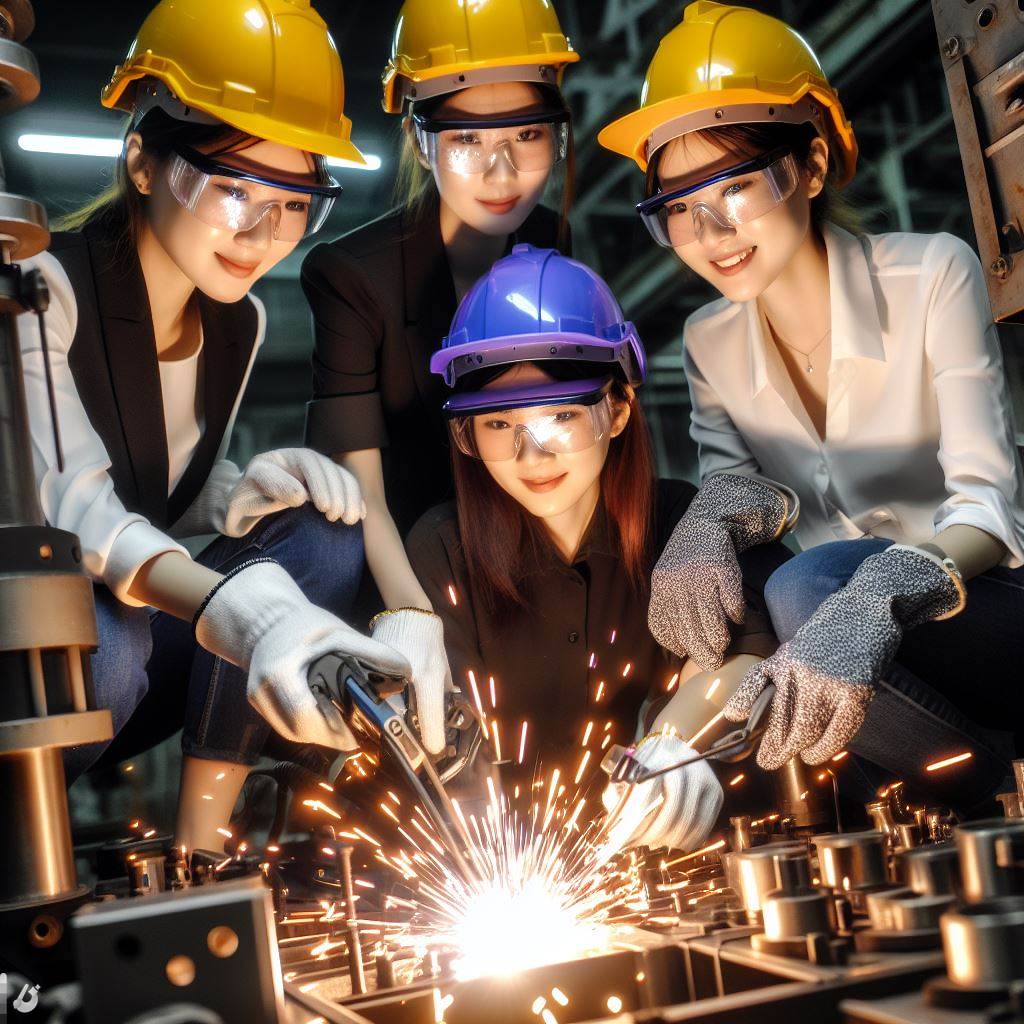Introduction
Breaking Barriers: Women Thriving in Mech Engineering
Women excel in mech engineering, driving innovation and progress in a historically male-dominated field.
Supportive policies, like flexible work hours and parental leave, empower women to balance work and life effectively.
Inclusive environments value diversity, fostering collaboration, and unleashing the full potential of women’s contributions.
Mentorship programs guide women through challenges, providing valuable insights from experienced professionals in mech engineering.
Corporate diversity initiatives tackle gender biases, ensuring equal opportunities and fair practices for women in the industry.
Affinity groups and employee networks create a supportive community, connecting women in mech engineering for shared experiences and support.
Progress in gender diversity is evident, but ongoing efforts, advocacy, and initiatives are crucial for a truly inclusive mech engineering field.
Historical Overview of Women in Mech Engineering
Challenges and Barriers Faced by Women in Pursuing a Career in Mechanical Engineering Historically
- Limited educational opportunities: Women faced restricted access to engineering education, with universities barring them from technical programs.
- Stereotypes and bias: Society viewed engineering as a male-dominated field, leading to prejudices against women’s abilities and potential.
- Discrimination in the workplace: Even if women managed to obtain engineering degrees, they often faced discrimination and exclusion in professional settings.
- Lack of mentorship and support systems: Women lacked role models and mentors who could guide and support them in their engineering careers.
- Limited networking opportunities: Women were often excluded from professional networks, making it difficult for them to connect with potential employers or advance in their careers.
- Balancing work and family responsibilities: Society expected women to prioritize family duties, making it challenging for them to pursue demanding careers like mechanical engineering.
Pioneers and Trailblazers Who Paved the Way for Future Generations of Women in the Field
- Edith Clarke: In 1919, she became the first woman to earn an electrical engineering degree from the Massachusetts Institute of Technology.
- Beatrice Hicks: In 1956, Hicks became the first woman to earn a Ph.D. in mechanical engineering and the first female engineer at the NASA Lewis Research Center.
- Lillian Gilbreth: An industrial engineer, Gilbreth was the first female member of the American Society of Mechanical Engineers and a pioneer in applying psychology to engineering.
- Mary Anderson: In 1869, Anderson received a patent for inventing the windshield wiper, demonstrating women’s engineering prowess.
- Hilda Meryck: She was the first woman in the UK to receive an Honors Degree in Mechanical Engineering in 1930.
- Ellen Swallow Richards: Richards became the first female member of the American Institute of Mining and Metallurgical Engineering and played a pivotal role in promoting sanitary engineering.
These pioneering women overcame significant challenges and paved the way for future generations of women in mechanical engineering.
They defied societal expectations, shattered glass ceilings, and showed that women could excel in the field.
It is essential to acknowledge and celebrate their contributions, as they have created opportunities for women today.
Despite the progress made, gender disparities in mechanical engineering still exist.
However, thanks to the trailblazers’ efforts, more women are entering the field than ever before.
Organizations and initiatives promoting gender equality and diversity encourage women to pursue careers in mechanical engineering and provide support throughout their journey.
In the next section, we will explore the current state of women in mechanical engineering and the initiatives aimed at further advancing gender equality in the field.
Read: Work-Life Balance in Civil Engineering
Current Statistics and Trends
Present current statistics and data on women’s representation in the field of mechanical engineering
- According to the National Science Foundation, women accounted for only 13.8% of mechanical engineering degrees earned in 2018.
- The Society of Women Engineers reported that as of 2019, women made up only 15% of the engineering workforce.
- While women represent almost half of the total workforce in the United States, their representation in mechanical engineering remains significantly low.
- The statistics highlight a clear gender disparity in the field, with women being underrepresented in mechanical engineering.
Noticeable trends or changes in recent years
- There has been a slight increase in the number of women pursuing mechanical engineering degrees in recent years.
- Data from the American Society of Mechanical Engineers indicates a gradual increase in women’s enrollment in mechanical engineering programs.
- The number of women joining professional organizations such as the Society of Women Engineers has been steadily growing.
- Despite these positive trends, the overall progress in women’s representation in mechanical engineering is still relatively slow.
The reasons behind the underrepresentation of women in mech engineering
- Societal stereotypes and biases play a significant role in discouraging women from pursuing careers in mechanical engineering.
- The perception that engineering is a male-dominated field creates a lack of representation and can deter women from entering the profession.
- Unconscious bias during the recruitment and promotion process can hinder women’s career progression in mechanical engineering.
- Workplace cultures that are not inclusive and supportive can make it difficult for women to succeed and thrive in the field.
- A lack of visible role models and mentorship opportunities for women in mechanical engineering further contributes to the underrepresentation.
- The STEM gender gap starts in early education, with girls facing social pressure that discourages their interest in science and engineering.
- Work-life balance challenges, including the demanding nature of engineering careers, can dissuade women from pursuing mechanical engineering.
Generally, the current statistics and trends in women’s representation in mechanical engineering reveal a significant gender disparity.
While there have been slight improvements in recent years, women remain underrepresented in the field.
Societal stereotypes, unconscious bias, workplace cultures, and educational factors all contribute to this underrepresentation.
Addressing these issues and promoting inclusivity and diversity in the field will be crucial to empower more women to pursue and succeed in mechanical engineering.
Read: Civil Engineering Tech: Innovations in Canada
Stereotypes and Gender Bias in Mech Engineering
The common stereotypes associated with women in the field
- Women are perceived as weak and incapable of handling the physical demands of mechanical engineering.
- There is a stereotype that women lack the necessary mathematical and technical skills for the field.
- It is commonly believed that women are more inclined towards “softer” disciplines like arts or social sciences.
- There is a notion that women are not interested in or passionate about engineering.
- Women are often considered as outsiders or anomalies in a male-dominated field.
The gender bias and discrimination women may face in education and workplace settings
- Women often experience bias from teachers and peers, resulting in discouragement to pursue mech engineering.
- In the workplace, women may face discrimination when it comes to hiring, promotions, and getting equal pay.
- Gender bias manifests in subtle ways such as being excluded from important projects or not being taken seriously.
- Women are often subjected to microaggressions and biased opinions about their capability and commitment.
- Sexual harassment and sexism are unfortunately prevalent issues that women encounter in mech engineering.
The impact of these stereotypes and bias on women’s participation in mech engineering
The perpetuation of stereotypes and gender bias in mech engineering has a significant impact on women’s participation in the field.
- Many talented and capable women are discouraged from pursuing mechanical engineering due to these preconceptions.
- Women may face imposter syndrome and lack confidence in their abilities because of the pervasive bias.
- The lack of female representation in the field perpetuates the stereotype that mech engineering is not for women.
- The absence of role models and mentors affects women’s ability to envision themselves succeeding in the field.
- Women may feel isolated and unsupported, leading to a higher attrition rate among female mech engineers.
Basically, stereotypes and gender bias have a detrimental impact on women in the field of mech engineering.
Addressing and dismantling these biases is crucial for creating a more inclusive and diverse engineering industry.
Read: Networking Tips for Civil Engineers in Canada

Efforts to Promote Gender Diversity
Present initiatives, programs, and organizations that aim to increase the representation of women in mech engineering
- Society of Women Engineers (SWE) offers scholarships, networking events, and mentorship programs.
- Women in Engineering ProActive Network (WEPAN) promotes inclusive cultures and organizational change.
- Girls Who Code provides opportunities for girls to learn coding and robotics from an early age.
- National Center for Women & Information Technology (NCWIT) works to close the gender gap in tech fields.
- The Women in STEM Initiative by UNESCO encourages girls to pursue careers in science, technology, engineering, and mathematics.
Success stories and testimonials from female mech engineers
- Sarah Thompson, a mech engineer, developed an innovative cooling system for electric vehicles.
- Karen Rodriguez, a leading figure in the field, designed a groundbreaking aerospace propulsion system.
- Lisa Chen, a prominent mech engineer, received recognition for her contribution to sustainable energy solutions.
- Maria Lopez, a female mech engineer, excels in robotics and automation, revolutionizing industrial processes.
- Emma Adams, a rising star in mech engineering, invented a cost-effective water purification system.
The impact of supportive policies and environments on women’s career advancement in the field
- Flexible work hours and parental leave policies enable work-life balance for women pursuing mech engineering careers.
- Inclusive and supportive work environments foster collaboration and encourage women’s contributions.
- Mentorship programs provide guidance and support to women, helping them navigate their career paths.
- Corporate diversity initiatives ensure equal opportunities for women and combat gender biases.
- Affinity groups and employee resource networks create a sense of community for women in mech engineering.
Efforts to promote gender diversity in the field of mech engineering have been on the rise.
Various initiatives, programs, and organizations are working towards increasing the representation of women in the field.
The Society of Women Engineers (SWE) plays a significant role in supporting women through scholarships, networking events, and mentorship programs.
Similarly, the Women in Engineering ProActive Network (WEPAN) focuses on promoting inclusive cultures and driving organizational change to increase gender diversity.
Inspiring girls from a young age is crucial.
Girls Who Code offers opportunities for girls to learn coding and robotics, breaking gender stereotypes in tech-related fields.
The National Center for Women & Information Technology (NCWIT) aims to close the gender gap in technology professions through concerted efforts.
Success stories and testimonials from women who have excelled in mech engineering serve as powerful examples for aspiring female engineers.
Sarah Thompson, a mech engineer, developed a groundbreaking cooling system for electric vehicles, contributing to environmental sustainability.
Karen Rodriguez’s innovative designs in aerospace propulsion systems have earned her a prominent position in the field.
Advancing Women in Mech Engineering: Policies, Mentorship, and Community
Supportive policies and environments are pivotal in advancing women’s careers in mech engineering.
Flexible work hours and parental leave policies enable women to manage work-life balance effectively.
Inclusive work environments that value diversity foster collaboration and nurture women’s contributions, leading to innovation and progress.
Mentorship programs also play a vital role.
Having guidance and support from experienced professionals helps women navigate career challenges and make informed decisions.
Corporate diversity initiatives ensure equal opportunities for women by addressing gender biases and promoting fair practices.
Affinity groups and employee resource networks are instrumental in creating a sense of community.
They provide a platform for women in mech engineering to connect, share experiences, and support each other.
Efforts to promote gender diversity in mech engineering have shown promising results.
However, there is still work to be done. Continued support, advocacy, and initiatives aimed at inspiring and empowering women will contribute to a more inclusive and diverse mech engineering field.
Unlock Your Career Potential
Visualize a clear path to success with our tailored Career Consulting service. Personalized insights in just 1-3 days.
Get StartedRead: Civil Engineering Licenses in Canada Explained
Uncover the Details: Diversity in Canada’s Electrical Engineering Field
Challenges and Solutions for Women in Mech Engineering
The unique challenges women may face in mech engineering
- Gender bias and discrimination in the workplace, such as unequal opportunities and pay.
- Lack of representation and support networks, leading to feelings of isolation.
- Negative stereotypes and societal expectations undermining women’s competence in technical fields.
- Struggles with work-life balance, particularly if they choose to have a family.
- Unconscious bias leading to underestimation of women’s abilities and potential.
Possible strategies and solutions to overcome these challenges and support women in the field
- Encourage inclusive hiring practices that prioritize merit and diversity.
- Implement mentorship and sponsorship programs to provide guidance and support to women.
- Promote awareness and education about unconscious bias and its impact on women’s careers.
- Create a safe and respectful work environment that values diversity and inclusion.
- Offer professional development opportunities for women to enhance their skills and knowledge.
- Celebrate and promote the achievements and contributions of women in mech engineering.
Resources and advice for women interested in pursuing a career in mech engineering
For women considering a career in mech engineering, it is crucial to have access to resources and support networks that will help them navigate challenges and succeed in the field.
Here are some valuable resources and advice:
- Join professional organizations like the Society of Women Engineers (SWE) to connect with other women in the field.
- Seek out female mentors and establish relationships with industry professionals who can provide guidance.
- Take advantage of scholarships and grants specifically aimed at supporting women in STEM fields.
- Stay informed about the latest trends and advancements in mech engineering through continuous learning.
- Develop strong technical skills and build a solid foundation in math and physics.
- Build a strong professional network by attending conferences, workshops, and industry events.
- Don’t be afraid to speak up and assert yourself in the workplace.
- Find a healthy work-life balance that suits your personal circumstances and priorities.
- Nurture your self-confidence and believe in your abilities, even in the face of adversity.
- Never underestimate the power of resilience and perseverance.
Despite the challenges women in mech engineering may face, the field offers immense opportunities for personal and professional growth.
By addressing gender biases, promoting inclusivity, and providing the necessary support, we can create an environment where women can thrive and contribute their unique perspectives and skills to the world of mech engineering.
Learn More: Famous Canadian Architects and Their Works
Conclusion
In this blog post, we have discussed the challenges faced by women in the field of mechanical engineering.
It is crucial to emphasize the importance of encouraging more women to enter this field.
By increasing the number of women in mechanical engineering, we can bring diverse perspectives and innovative solutions.
It’s time to dismantle the gender stereotypes and inequalities that hinder women’s progress in this industry.
Empowering women in mechanical engineering will lead to a more inclusive and successful future for the field.
Let us support and celebrate the achievements of women in this field, inspiring future generations to follow their passion for engineering.
Whether it is through mentorship, advocacy, or providing equal opportunities, we all have a role to play.
Together, let’s create a supportive environment where women in mechanical engineering thrive and make significant contributions.
It’s time to break the barriers and build a more equal and diverse world of mechanical engineering.
Join us in empowering women and paving the way for a brighter future in this dynamic field.




